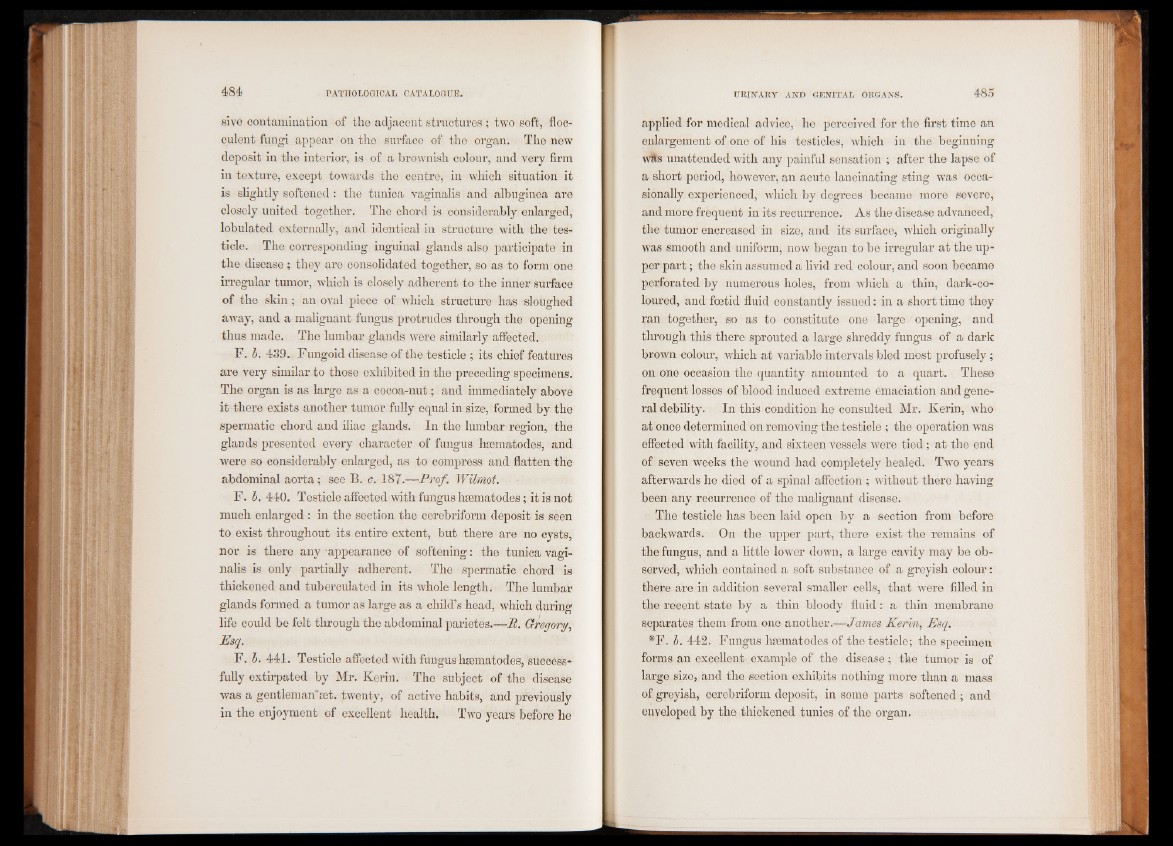
sive contamination of the adjacent structures ; two soft, floc-
culent fungi appear on the surface of the organ. The new
deposit in the interior, is of a brownish colour, and very firm
in texture, except towards the centre, in which situation it
is slightly softened : the tunica vaginalis and albuginea are
closely united together. The chord is considerably enlarged,
lobulated externally, and identical in structure with the testicle.
The corresponding inguinal glands also participate in
the disease ; they are consolidated together, so as to form one
irregular tumor, which is closely adherent to the inner surface
of the skin; an oval piece of which structure has sloughed
away, and a malignant fungus protrudes through the opening
thus made. The lumbar glands were similarly affected.
F. b. 439.. Fungoid disease of the testicle ; its chief features
are very similar to those exhibited in the preceding specimens.
The organ is as large as a cocoa-nut; and immediately above
it there exists another tumor fully equal in size, formed by the
spermatic chord and iliac glands. In the lumbar region, the
glands presented every character of fungus hsematodes, and
were so considerably enlarged, as to compress and flatten the
abdominal aorta; see B. c. 187.—Prof. Wilmot.
F. b. 440. Testicle affected with fungus hsematodes; it is not
much enlarged : in the section the cerebriform deposit is seen
to exist throughout its entire extent, but there are no cysts,
nor is there any -appearance of softening: the tunica vaginalis
is only partially adherent. The spermatic chord is
thickened and tuberculated in its whole length. The lumbar
glands formed a tumor as large as a child’s head, which during
life could be felt through the abdominal parietes.—B. Gregory,
Esq.
F. b. 441. Testicle affected with fun gus hsematodes, successfully
extirpated by Mr. Kerin. The subject of the disease
was a gentleman*iet. twenty, of active habits, and previously
in the enjoyment of excellent health. Two years before he
applied for medical advice, he perceived for the first time an
enlargement of one of his testicles, which in the beginning
wSs unattended with any painful sensation ; after the lapse of
a short period, however, an acute lancinating sting was occasionally
experienced, which by degrees became more severe,
and more frequent in its recurrence. As the disease advanced,
the tumor encreased in size, and its surface, which originally
was smooth and uniform, now began to be irregular at the upper
part; the skin assumed a livid red colour, and soon became
perforated by numerous holes, from which a thin, dark-coloured,
and foetid fluid constantly issued: in a short time they
ran together, so as to constitute one large opening, and
through this there sprouted a large shreddy fungus of a dark
brown colour, which at variable intervals bled most profusely;
on one occasion the quantity amounted to a quart. These
frequent losses of blood induced extreme emaciation and general
debility. In this condition he consulted Mr. Kerin, who
at once determined on removing the testicle ; the operation was
effected with facility, and sixteen vessels were tied; at the end
of seven weeks the wound had completely healed. Two years
afterwards he died of a spinal affection ; without there having
been any recurrence of the malignant disease.
The testicle has been laid open by a section from before
backwards. On the upper part, there exist the remains of
the fungus, and a little lower down, a large cavity may be observed,
which contained a soft substance of a greyish colour:
there are in addition several smaller cells, that were filled in
the recent state by a thin bloody fluid: a thin membrane
separates them from one another.—James Kerin, Esq.
*F, b. 442. Fungus hsematodes of the testicle; the specimen
forms an excellent example of the disease; the tumor is of
large size, and the section exhibits nothing more than a mass
of greyish, cerebriform deposit, in some parts softened ; and
enveloped by the thickened tunics of the organ.